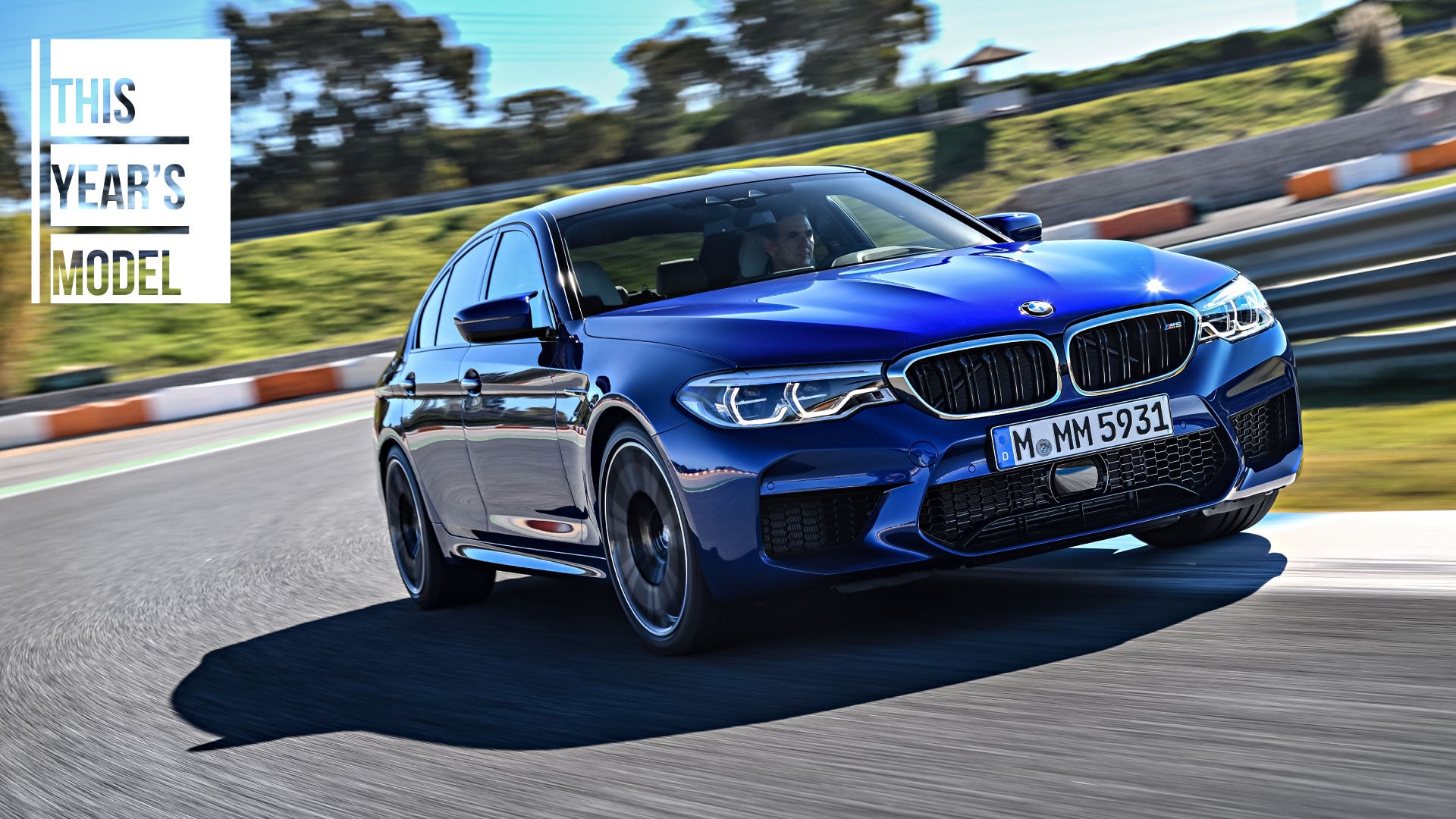It’s official: BMW's best-known sport sedan has joined the 600 Club, with an on-the-dot 600 horsepower for the 2018 M5. No longer must an M5 driver shrink, whether in conversation or manly measurements, against owners of the 603-hp Mercedes-AMG E63 S, the 640-hp Cadillac CTS-V, or the 605-hp Audi RS 7 Performance.
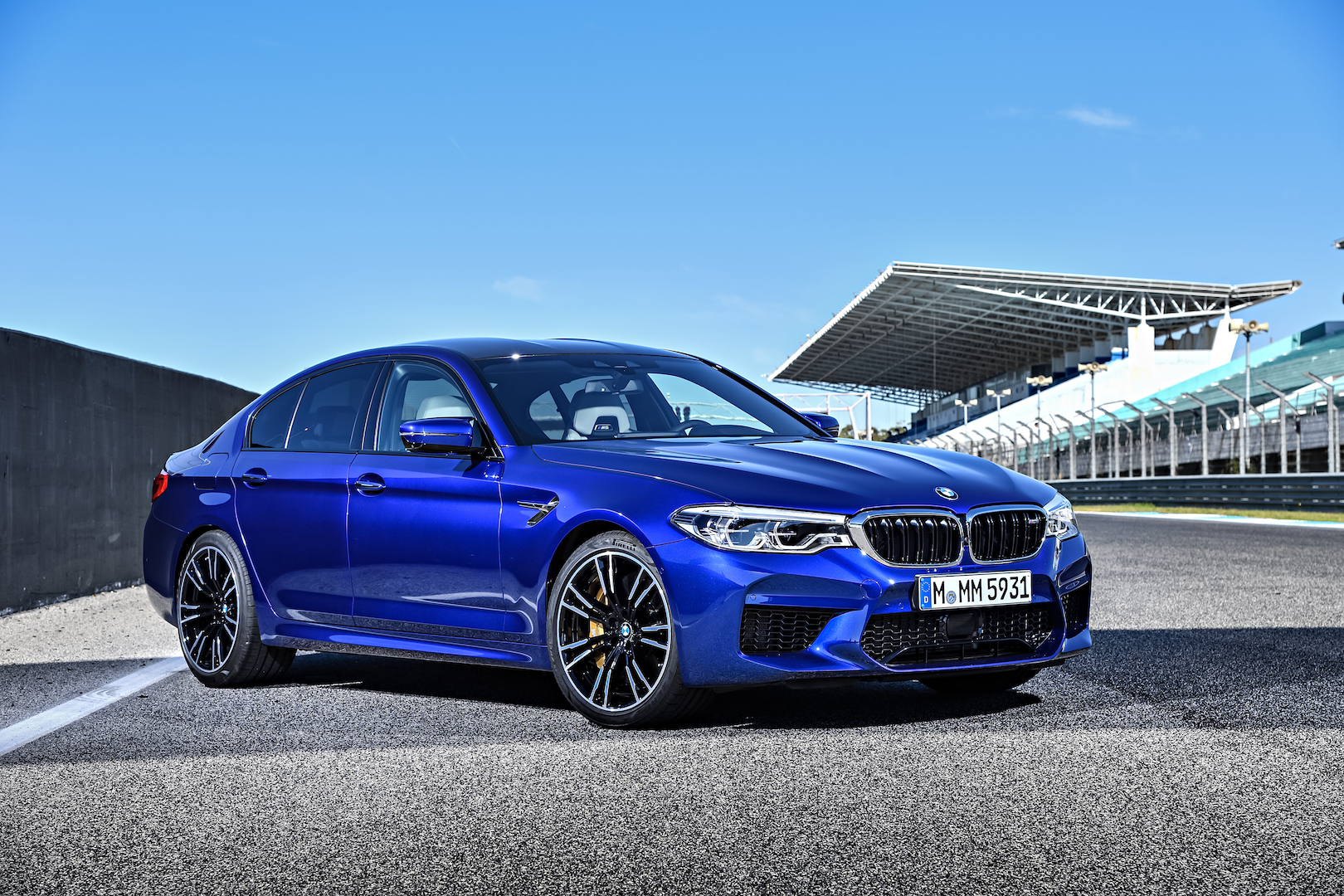
Aside from the industry’s (increasingly pointless) horsepower wars, the more telling number for the M5 is actually “four.” That’s how many wheels the BMW is churning during the first drive event at Circuito Estoril, the fast-flowing, retired Formula One track where Ayrton Senna scored his first series win at the Portuguese Grand Prix in 1985. In so many ways, this M5 upends everything we knew to be true of both BMWs and performance itself: This family-sized sedan harnesses all-wheel-drive, electrically-boosted power steering, and a conventional torque-converter automatic transmission. Yet somehow, it proves a far more engaging car than its predecessor that relied on traditional rear-wheel-drive, a hydraulic rack, and a fancy dual-clutch gearbox. In the final indignity for purists, you can’t choose a manual transmission, although only a speck of buyers in America—and surprisingly, even fewer in Europe—were choosing a stick anyway.

Over its six-year run, the previous M5 brought 560 horsepower of its own, or 575 with its Competition Package. Yet that M5 was surely the least compelling of the car’s five generations. Like the A.I. in Ex Machina, it was shapely, smart, and desirable on paper, but also an icy automaton whose personality and responses seemed disturbingly synthetic. That car’s “meh” status in the pantheon is driven home at Estoril, where BMW Classic lines up a wondrous sampler of vintage M5s for our nostalgic driving pleasure—including a 1992 E34 model with pretty Daytona Violet paint, a five-speed stick and a 340-hp inline six and a fourth-generation M5 with its exotic, 500-hp V-10.
This new, sixth-generation M5 may lack that clutch-stepping fun, but it needn’t apologize for anything else. That includes its eight-speed, paddle-shifted ZF automatic transmission. Its torque convertor eliminates the occasional low-speed lurches of the previous dual-clutch unit, but locks up fully above roughly 3 mph, so it's a virtual wash from there. (The transmission is still no Porsche PDK, but then, nothing is). Once in motion, the M Steptronic unit operates with all the speed, smarts, and throttle blips you’ll require, including a button atop the handsomely reworked console lever that selects a trio of shift programs.

As it happens, I’m the first sleep-deprived journalist in our group to hit the Estoril track, in a lead-follow behind Nico Menzel—the baby-faced German racer from the same BMW Junior Programme that spawned F1 stars Sebastian Vettel and Nico Rosberg. And as soon I get some heat in the 20-inch Pirelli P Zero tires on this chilly Portuguese morning, the M5’s newfound ferocity and playfulness slaps me awake like a thermos full of espresso.
After a single recon lap, damn him, Menzel begins drifting and collecting the M5 under throttle like the 20-year-old hard charger he is, barbecuing the rear tires like a pair of greasy wursts. It’s barely 9 a.m., but it’s go time—and fun time. I’m working my un-warmed butt off to keep up, hammering the M5 down the grandstand straight as early-morning marbles shoot off Menzel’s tires and straight into my windshield, a gritstorm so intense that I’m certain the glass will splinter at any second.
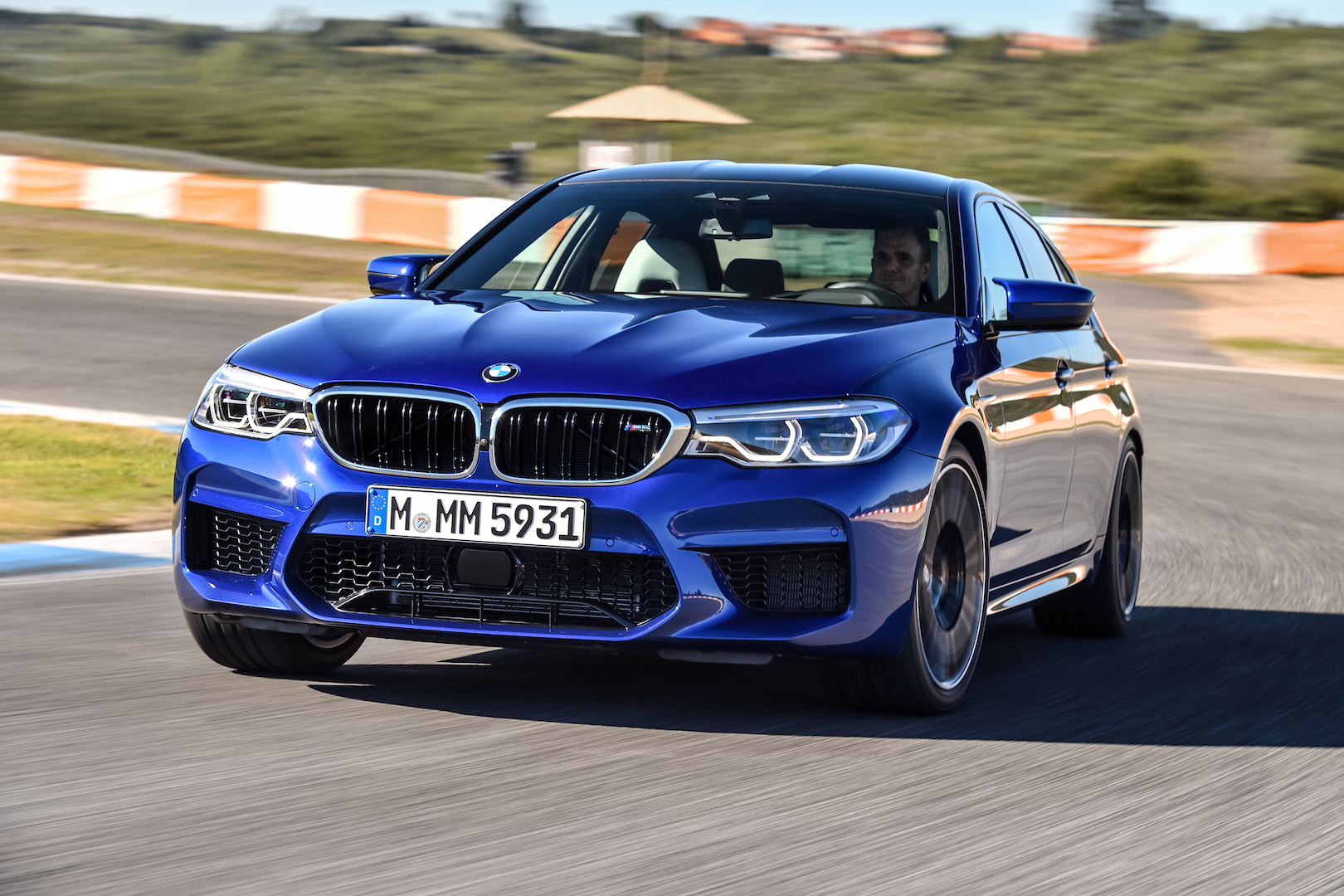
Wait, you may ask, I thought this was a four-wheel-drive M5? Si, but only when you need or want it. Even beyond its gym-toned, twin-turbo 4.4-liter V8, an unshackled exhaust note, and other upgrades, the M division’s lavishly reworked xDrive AWD is this car’s real Ace of Spades. Owners will deal those four cards from a newly shuffled deck that includes two crimson metal switches affixed to the chunky, tactile M steering wheel. These programmable macro switches—M1 on the left, M2 on the right—save your settings for the AWD, new aluminum-bodied dampers, steering, throttle, transmission, and traction/stability control.
This Einstein-level M xDrive adds about 130 pounds to the M5, yet it’s worth every ounce to get those 600 horses to the pavement. (BMW claims the car, at 4,370 pounds, is still 33 pounds lighter overall than its predecessor, thanks to a more aluminum-intensive chassis, a lithium-ion battery, and other weight-savers). New carbon plates connect the electronic limited-slip rear differential, which divvies power between the rear wheels from 0 to 100 percent locking effect. The center transfer case adds carbon-fiber plates for its electromechanical clutch, able to engage or disengage front wheels in milliseconds.
Everything is controlled via a Central Intelligence Unit that ruthlessly analyzes real-time driving parameters and assigns power to any of the four wheels according to five selectable driving modes. Even the standard "4WD" setting favors rear-driven power in the interest of handling and fuel economy. It also gives the M5 newfound four-season skills that owners will bless when they’re guiding this beast up snowy mountains or slippery driveways. But the general philosophy is one that any BMW adherent will welcome: Keep electronic traction and stability interventions to the minimum, and elevate the human driver to the maximum.
I’ve dialed in a hot set-up for tracks or thumbing your nose at Johnny Law on public roads: 4WD with M Dynamic program. which allows serious tail-wagging before the stability systems kick in. Front tires only come into power play when the rears are absolutely incapable of transmitting more force. Taking a tip from both M engineers and pro drivers, I slot the steering in the mid-range Sport setting...which tells you that its Sport Plus mode is both excessively firm and entirely superfluous. Whichever set-up you choose, the BMW feels more responsive than before, thanks to a host of changes that include that stiffer, lighter platform and a revised suspension and steering geometry. The front axle track is 0.8-inches wider. A web of black tube braces spans the underhood area and front radiator—the latter one of nine coolers for the engine, transmission and turbos.
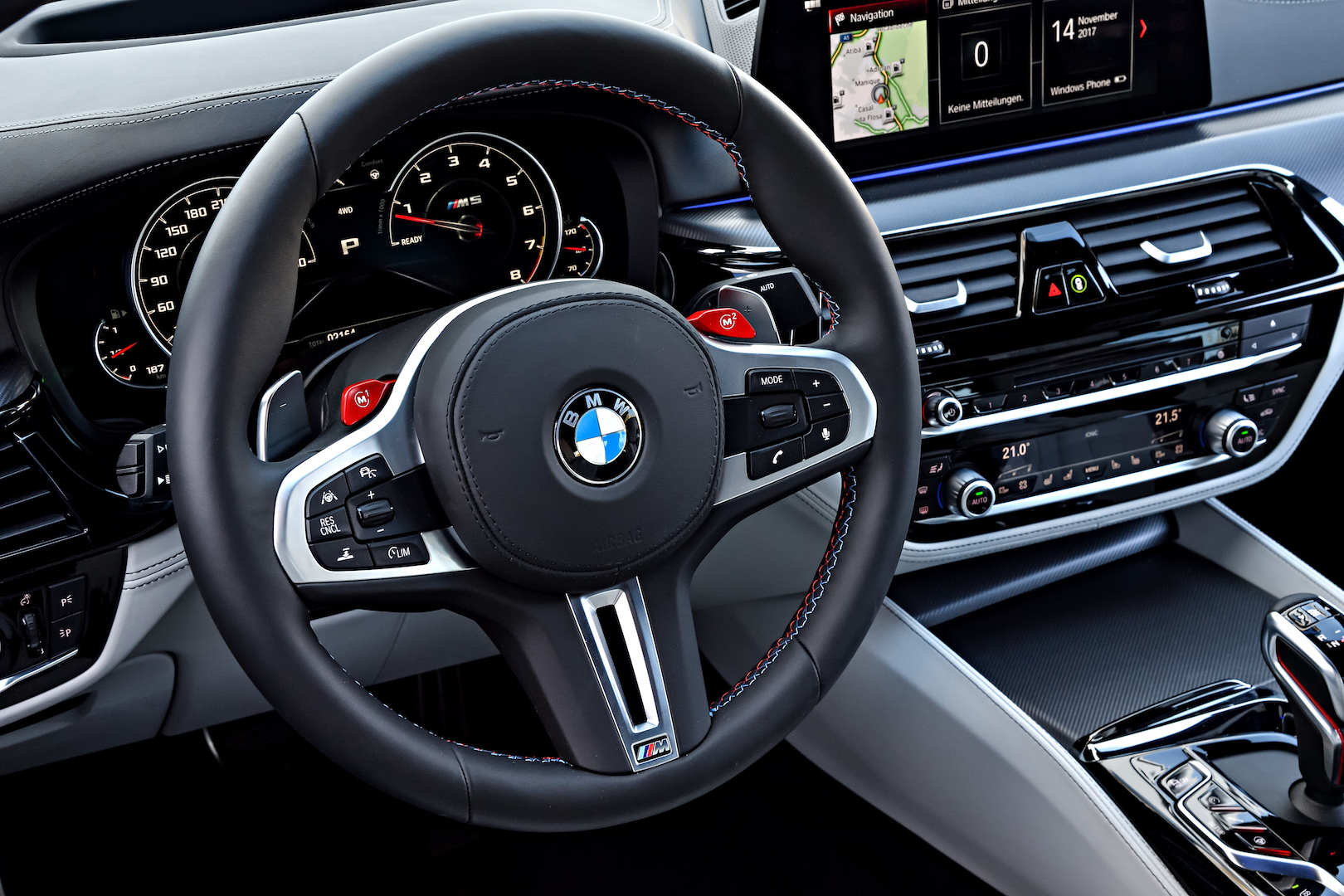
The steering ratio is 25-percent quicker, with lively tuning that takes valuable lessons from electric-assisted models like the M3, M4, and now M2. There’s still not a ton of feedback from the road surface—Cadillac’s CTS-V is still the Mr. Sensitive of beefcake sport sedans—but the M5 tracks with laser accuracy and attacks corners with vigor. And where the departing model would basically quit near the traction limits of its rear tires, this one is just getting started: Like galley oarsmen in Ben Hur, the front tires spring into action to help this big boat maneuver and dig out of corners. This M5 actually carries 10-mm narrower rear tires than before at 285/30/ZR20, a testament to its improved four-corner balance. And it all happens in transparent, delightful fashion, similar to how the Huracan and other new Lamborghinis use AWD to quell understeer and promote neutral handling—the precise opposite of the way primitive AWD systems used to work. A push of the throttle here, some countersteer there, and I’m performing ballet in a two-plus-ton luxury sedan.
“You can now go fast in any conditions,” says Carsten Wolf, the M5’s powertrain chief. “It’s always predictable, and you don’t have to fight the car.”

If you’d prefer more of a tussle, the M5 will still oblige: A screen-selectable 2WD mode decouples front wheels entirely, no-matter-freaking-what. Traction and stability control are now verboten, and you can also shut off the helpers entirely in 4WD M Dynamic mode. Moving to two-laners in the Portuguese countryside, I lay down a couple of smoky burnouts in 2WD mode, just to prove I can. Old-school types who insist on tempting fate or toasting tires are welcome to it, though I suspect that most drivers will rarely find a situation that calls for rear-drive mode, whether on road or track. M Division engineers admit as much, that the mode is largely about appeasing customers who view rear-driven purity as a core BMW value, even if many of them will never dare drift or squeal their M5 in real life. Consider it the simultaneous opposite and equivalent of 4WD SUVs for suburbanites who barely venture beyond their subdivision.
For one, the BMW is fastest in its AWD modes. It launches to 60 mph in a supercar-baiting 3.2 seconds, and to 124 mph (200 kph) in 11.1 seconds. The rear-driven CTS-V, despite 40 extra horses, is a half-second slower to 60 mph. Mercedes quotes 3.3 seconds for its E63 S 4Matic. Ante up for the optional M Driver’s Package, and top speed peaks at 187 mph; it stands at the usual 155 mph for standard models. Our test cars are all fitted with optional carbon ceramic brakes (roughly $8,000), which save about seven pounds of weight at each corner. Standard models make do, nicely, with M compound brakes with inner-vented rotors.

I haven’t even mentioned the beastly engine. Over dinner, Wolf says that most internals for the 4.4-liter, direct-injection V8 remain unchanged. But fuel-injection pressure nearly doubles, from 200 to 350 bar. A pair of twin-scroll turbochargers keep their optimal “hot-V” positioning between cylinder banks, but their compressors are larger, and intercoolers are 28-percent more efficient. Electric turbo wastegates replace pneumatic controls for faster throttle response. A modified exhaust system reduces backpressure and trims 11 pounds. Torque jumps by a lusty 10 percent, from 500 pound-feet to 553. That max torque summits by 1,800 rpm and stays tabletop-flat until 5,600 rpm. Redline chasers will appreciate a significant rise to 7,200 rpm, up from 6,800. A cool “pre-warning field” in the striking new instrument cluster flashes concentric animated rings as you approach redline. Shift lights can also flash in BMW’s excellent head-up display—the current industry benchmark, in my view—which now offers a 75-percent larger viewing area.
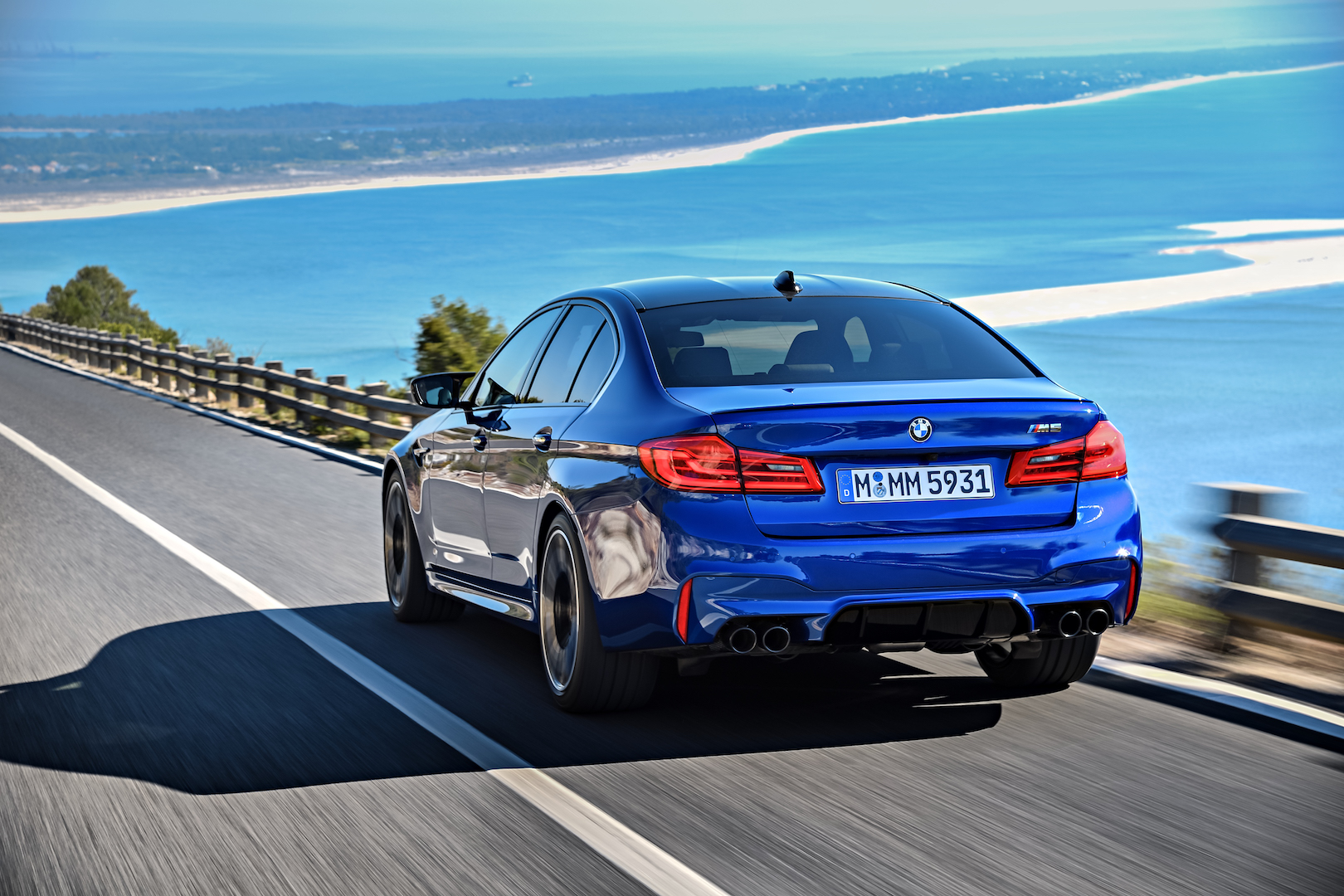
The optional sport exhaust system seems a must, if only to completely distance this M5 from its tame, congested-sounding predecessor. That exhaust note still isn’t as bar-fight bawdy as the Mercedes E63’s biturbo 4.0-liter, one of the meanest-sounding V8s on the planet. But this M5’s baritone thrum speaks fluently of money and M engineering, as though every pricey mechanical was spinning up a cash-register total. In fact, that distinctive tone literally speaks to the efficiency inside: The BMW V8’s turbochargers harvest exhaust in a unique cylinder order to deliver steadier impulses to its compressors. Yes, the BMW still adds some simulated engine frequencies through the fine Bowers & Wilkins audio system. But for all the backlash over this digital enhancement, it takes a conductor’s ear to detect any back-up singers over the natural engine induction and crackling exhaust.
My biggest quibble isn’t aural, but visual. As I pore over the new and previous model, this M5’s design doesn’t trumpet that newness. Tellingly, one company press release on the car doesn’t include anything—not one sentence, flowery phrase, or detail—about the exterior changes. The aluminum hood has more pronounced ripples. Front inlets gape a bit more, with new headlamps and taillamps. There’s a thicker-finned rear diffuser and a quartet of black-tipped exhaust outlets. Multi-spoke alloy wheels look great, per usual. The M5 is undeniably handsome, with a nice Germanic balance of sleekness and aggression, but a bit too familiar.
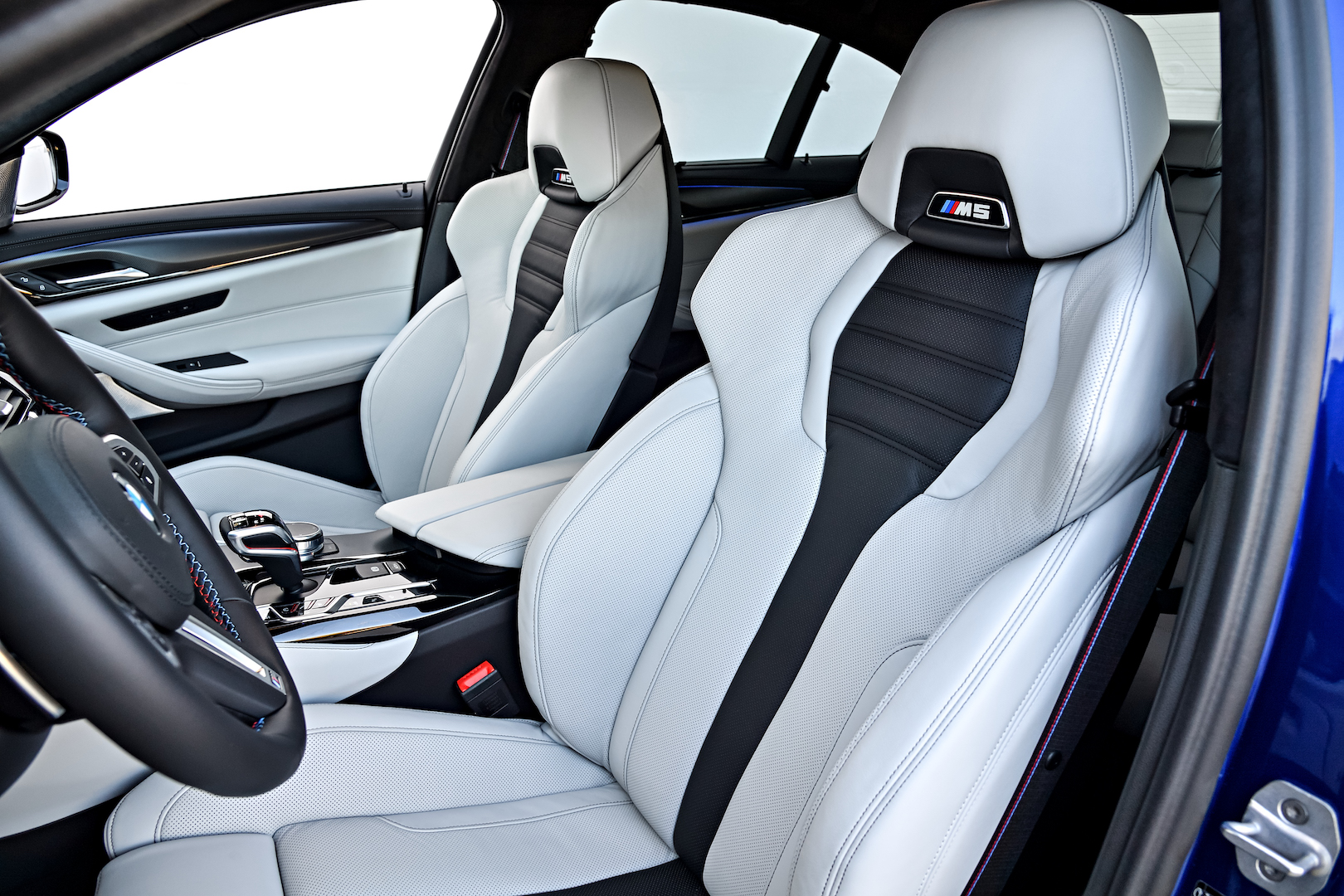
The car does look and feel more special inside, better worthy of that base price of $103,595. Dramatic, wide-winged sport seats, especially in off-white leather with black inserts, really pop against the ebony steering wheel, slim dashboard and luxurious trimmings. That base price represents an $8,500 jump over the old model; it’s $15,500 more than the CTS-V (at $88,490), but $1,800 less than the Benz/AMG E63 S. Welcome to the club of high-lux sport sedans: If 600 is the address for horsepower, $100,000 is the new price of admission.
This new M5 brings the appropriate luxury and tech, a surfeit of speed. Yet I’m still bracing for a few offhand digs, especially from the self-regarding enthusiast press, about how BMW doesn’t build ‘em like they used to. Some will tell you that BMW has forgotten how to build an Ultimate Driving Machine at all.
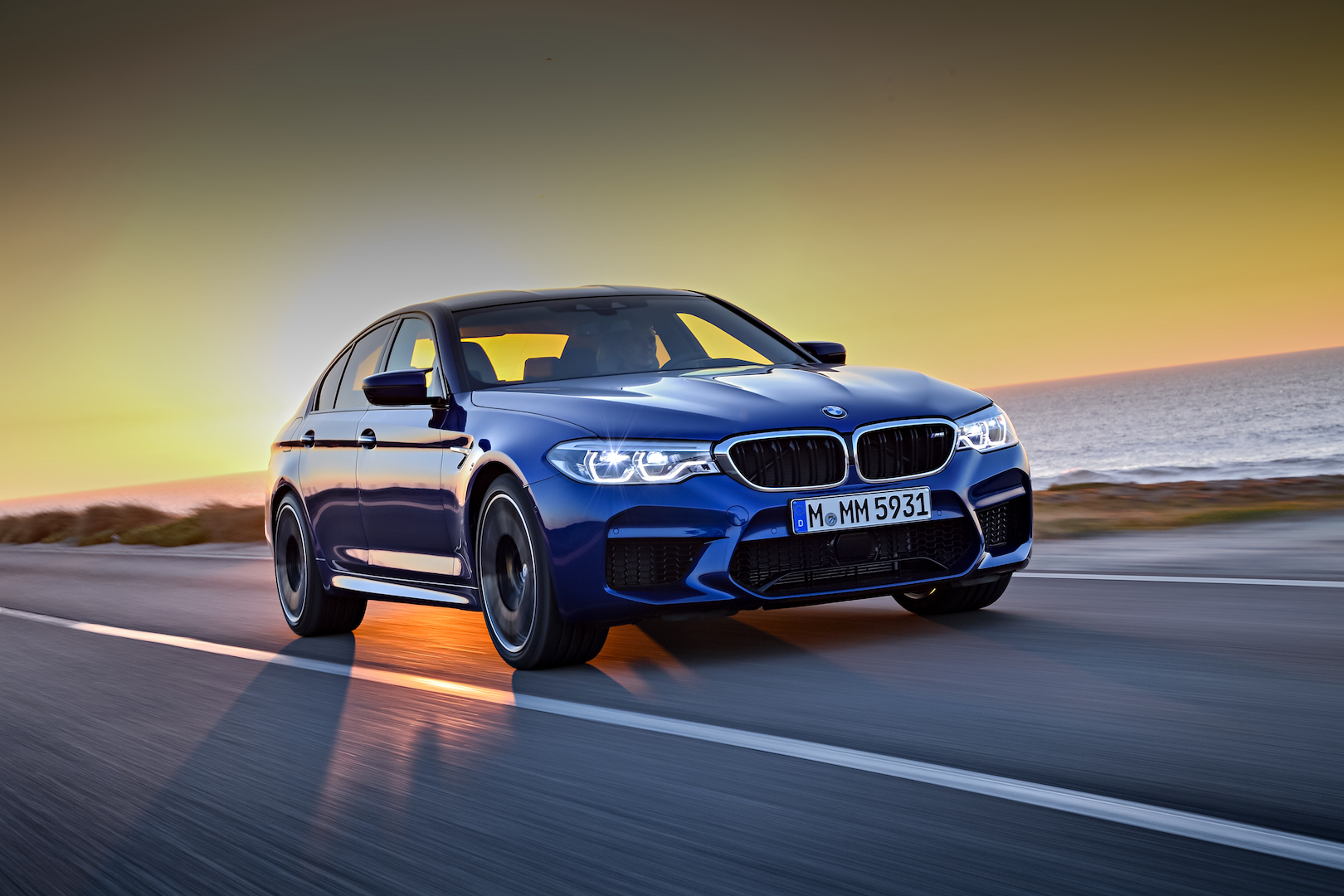
Objective evidence, and my own seat-of-pants experience, says otherwise. Sure, BMW has made missteps and disappointed some traditionalists, as has every luxury automaker. From its South Carolina plant, it produces literal boatloads of SUVs. So does every automaker that hopes to stay in business. Yet the gangbusters M Division alone will top 70,000 global sales this year, and a projected 100,000 by 2020. That’s a remarkable sextupling of M-car muscle, up from just 17,000 sales in 2010. Let’s crunch numbers, minus the sour grapes: I count M2, M3, M4, M5, M6, X5M, X6M, and i8 sports car, with an M8 coupe, Z5 roadster, and more in the pipeline. That’s not even counting some highly compelling M Performance models, including the X3 M40i, M550i and M760i. Oh, but BMW doesn’t make performance cars anymore.
What a crock. Those Bimmers aren’t all best-in-class, but virtually every one is in the conversation for the Top Three. And this isn’t 1987 anymore, when Jaguars and Cadillacs were lemony jokes, Audis were slow-and-faux VW’s, and Mercedes was building cars for your granddad. Those rivals, and more, discovered (or rediscovered) high performance and worked overtime to catch up to—and in some cases surpass—the once unchallenged Bavarian kings.
Bottom line, it’s not BMW’s fault that cars like the E63 AMG and CTS-V exist. Such brilliant rivals have made the game more interesting and competitive, better for everyone. But this M5 will go mano a mano with them, or any sport sedan. And it definitely took 600 horsepower to do it.
Lawrence Ulrich,The Autance’s chief auto critic, is an award-winning auto journalist and former chief auto critic for The New York Times and Detroit Free Press. The Detroit native and Brooklyn gentrifier owns a troubled ’93 Mazda RX-7 R1, but may want to give it a good home. Email him at [email protected].
